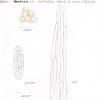
03-07-2016 15:59
 Jakob Schneller
Jakob Schneller
Dear collegues I have recently found this fun

01-07-2016 21:36
no se si alguien puede darme alguna sugerenciaJose

01-07-2016 02:17
 Viktorie Halasu
Viktorie Halasu
Good evening,I would like to ask your opinion on t

01-07-2016 14:56
 Rubén Martínez-Gil
Rubén Martínez-Gil
Hola a todos. Hace unos meses hice fotos micro de

28-06-2016 08:52
en semilla de CastaneaEjemplares en seco que he re
 Hi,
Hi,Collected in October 1992 on decaying petioles of Petasites hybridus:
Perithecia superficial, gregarious, subglobose, flattened upper part, 0.3-0.4(0.5) mm diam., indistinct papillate, yellow-orange, with a crown of spreading, hyaline hairs.
Asci 8-spored, 73-83x9-10 µm.
Spores narrowly ellipsoid, 18-23(25)x5.5-7 µm, 1-septate, filled with 1-2 µm diam. guttules, smooth, hyaline.
Perithecial wall of textura angularis. Processes tapering, up to 115x13 µm, composed of agglutinated 2 µm diam. hyphae, hyaline.
Only a drawing available. Any idea? Thanks in advance.

Description of ascomatal wall, colour of perithecia in KOH as well as in lactic acid are required.
If there is no changing colour, you have choice among four genera:
Lasionectria, Lasionectriella, Ijuhya and Hydropisphaera, which are separated by characteristics of the cells composing the wall.
Did you see some orange, oily droplets in ascomatal wall or in hymenium?
Good luck
Christian
